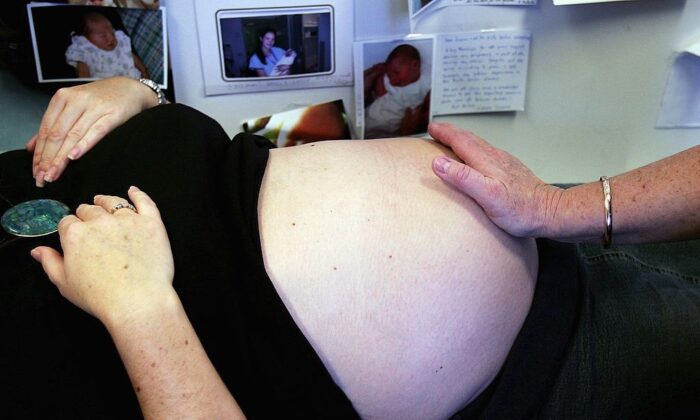The issue of domestic violence dominated headlines this past week, but is there more to the story?
Commentary
Prime Minister Anthony Albanese would have been better off not attending the Violence Against Women Rally in Canberra.
Not just because he got some avoidable bad press, but because the whole idea of the rally was flawed from the start. He should not have given it tacit support.
First, the bad press. If you missed it, he reduced the organiser, Sarah Williams, to tears accusing her of refusing to let him or Senator Katy Gallagher speak.
“That’s a lie, that’s a full-out lie,” she said.
Then Mr. Albanese tried to press on while she was being comforted by fellow protestors. Not a good look for a man when you are making claims about “gendered” violence.
Second, to the bad policy and philosophy behind the protest.
The claim that domestic violence is all about toxic masculinity and misogyny is wrong, and taking that idea seriously stops us from confronting the real reasons for domestic violence and lures politicians into making all sorts of ludicrously unrealistic promises.
Stopping “men’s violence against women” is in the same category as the promise by a previous Australian Labor Prime Minister Bob Hawke that “no child would live in poverty?”
So, while hopelessly utopian, that is the demand inevitably made at these protests.
But it’s not only Albo who has bowed to the power of the gendered crowd. Both sides of politics have made promises and launched enquiries based on the presupposition that for some reason men kill women because they are women.
Maybe some do, but it is likely to be in very rare cases. Behaving as though this is a universal truth, and targeting your resources at an imaginary threat is a waste of those resources, and ignores the real problems.
 Australia's Prime Minister Anthony Albanese speaks during a National Cabinet meeting to address domestic violence at the Commonwealth Parliamentary Offices in Sydney, Australia on May 1, 2024. (Gaye Gerard/Pool/AFP via Getty Images)
Australia's Prime Minister Anthony Albanese speaks during a National Cabinet meeting to address domestic violence at the Commonwealth Parliamentary Offices in Sydney, Australia on May 1, 2024. (Gaye Gerard/Pool/AFP via Getty Images)Gender is Not a Major Motivator for Violence
According to the National Homicide Monitoring Program over the period since 1989, on average twice as many men were killed as women. Over the same period, on average, 86 percent of killers were male.
Many more men commit homicide, whether of an intimate partner or otherwise, but the gender that is disproportionately targeted is male, not female.
Men kill, and are violent, at greater rates than women, and that’s why they are more likely to be the perpetrators of domestic violence, not because of a relationship between the sexes.
And even though they are in the minority, women also kill women, as well as men. If men are driven to kill because of gender, what are women driven by?
That men kill at greater rates than women is not a “bug,” it is actually a feature of how we’ve survived as a species.
Men have for historical reasons acted violent, because violence is necessary to survive in a violent world, and there has been a division of labour where half the species is given to nurture, and the other to protecting the nurturer.
Rather than being designed to be violent towards women, men tend to be protective of them, because ultimately it is women and children—their family grouping’s future—that they are protecting. And their violence tends to be directed towards other males who they see as predatory.
 A woman shelters from the rain under an umbrella while crossing a street in Sydney, Australia on Oct. 6, 2022. (Muhammad Farooq/AFP via a Getty Images)
A woman shelters from the rain under an umbrella while crossing a street in Sydney, Australia on Oct. 6, 2022. (Muhammad Farooq/AFP via a Getty Images)And that is what you are seeing evidence of in the statistics.
It is partly this instinct that leads to the gender misdiagnosis being propagated. Because men are protective of women, they instinctively feel more aggrieved when a woman is harmed than a man, and as a result are embarrassed to push back against the narrative because they feel ashamed, even though it had nothing to do with them.
There are further wrinkles the popular analysis ignores that show wealth, education, and ethnicity can be factors with a larger effect than gender.
The murder rate is lowest in the Australian Capital Territory (average of 0.74 per thousand per year), and highest in the Northern Territory (average 6.98 per hundred thousand).
Victoria is the second lowest (1.08), then there is a jump up to Tasmania (1.23), then a further jump to New South Wales (1.29), then South Australia (1.33) followed by Queensland (1.43) and Western Australia (1.49).
This illustrates three issues.
First is that violence in Indigenous communities is enormous, accounting for 17 percent of total homicides. This dramatically influences state figures with the highest homicide rates being in those states and territories with the largest Aboriginal populations.
The other factor is socio-economic—violence increases in lower socio-demographics.
Without knowing anything else you could predict that our best-educated, wealthiest city, Canberra, would have the lowest murder rate. A similar distribution occurs within states.
Then there is the claim that this is a crisis.
The graph below shows the incidence of homicides since 1989-90 showing that they have more than halved. It also shows the incidence of intimate partner homicide. Total homicides have decreased by 52 percent while intimate partner homicides decreased by 73 percent.
At no time in the last 33 years have we been safer from our fellow Australians.
These figures are in isolation, what about the world context? As the map below shows Australia is again one of the safest countries in the world on the basis of homicide. And the scatter graph below breaks it down by sex, showing that not only is Australia a very safe country, it is safer for women than it is for men.
And the scatter graph below breaks it down by sex, showing that not only is Australia a very safe country, it is safer for women than it is for men. That is not to say that there is no room for improvement.
That is not to say that there is no room for improvement.
There will always be people who kill, and again as the graphs show, there are countries that still do much better than Australia.
Singling Out One Gender is Not Helpful
My personal experience suggests that the problem is not gender so much as situational. It is a couple problem and telling only one half of the couple to take responsibility tackles only half the problem.
Decades ago I did some inadvertent anthropological study of men who had committed domestic violence.
I was in a relationship that involved a lot of screaming and yelling, and teetered on the edge of violence, so I insisted we get counselling, which resulted in me being put in a “men’s group.”
There seemed to be three types out of the 15, maybe 20, men in the group. There were the patriarchal/misogynistic, the violent, and the vulnerable.
The patriarch was a recent Italian migrant, (say 6.7 percent of the sample) who didn’t seem to have adjusted to a culture where women were equal to men. Of the truly violent there was only one (6.7 percent again) and he was aggressive to those of us around the table, threatening to punch at least one person.
And then there were the rest (86.6 percent), men who could tell you how they felt, but for whom the problem was significantly situational, arising from their partnership dynamics. I know mine was as I’ve never had a problem in another relationship since.
The prime minister remarked at the rally that we need to “focus on perpetrators and focus on prevention,” so treating half the problem continues.
5 Ideas for Dealing With the Problem
First, treat this as a couple problem.
Both men and women need to deal with the situation better. It’s not right for your partner to hit you, but it’s not wise to put yourself in a position where this might happen, or even provoke it.
Learn to recognise the signs and avoid those situations. We apply risk minimisation in most other spheres of life, why not this one.
Second, target the geographical areas of high need where there is poverty and dysfunction and understand that the solution could actually be better economic opportunity, or activities that give a sense of self-worth.
Third, acknowledge Australia’s success relative to the past and the rest of the world today.
Understanding that there is no crisis will lead to saner policy outcomes while asserting there is one can even lead to policy paralysis.
Fourth, stop treating it as though it is a problem of gender. It only confuses and misdirects, and ultimately alienates the men you are trying to reach, at the same time as assuring the women of Australia that there is nothing they can do about it.
Fifth, spend some money studying the countries that do better than us.
Sixth, don’t go to rallies where people demand that “something must be done” unless you are prepared to refuse them.
Action for the sake of action is an abuse of the political process.
Views expressed in this article are opinions of the author and do not necessarily reflect the views of The Epoch Times.














 English (US) ·
English (US) ·  Turkish (TR) ·
Turkish (TR) ·